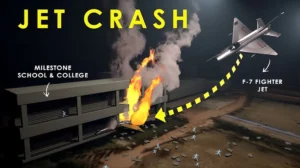Bangladesh Air Force Jet Crash: 21st July 2025
A Dark Day for Bangladesh
On the afternoon of 21 July 2025, tragedy struck the quiet Dhaka suburb of Diabari when a Bangladesh Air Force (BAF) fighter jet crashed into a school building during a routine training sortie. The incident, which unfolded in mere minutes, has since become one of the worst aviation disasters in the country’s history, with a death toll exceeding 27 and rising public outrage over preventable systemic failures.
Video Credits To https://www.youtube.com/@Aitelly
The Aircraft and the Mission
The aircraft involved was an F-7 BGI, a Chinese-built fighter jet used by the Bangladesh Air Force for training purposes. A two-seater variant, the F‑7 BGI has been in service for over a decade and is widely regarded as outdated by modern standards. On this occasion, the aircraft had taken off from A.K. Khandaker Air Base at approximately 1:06 p.m., with Flight Lieutenant Md Towkir Islam Sagar as the sole pilot aboard. It was a routine training flight, one of many flown weekly over the greater Dhaka region.
However, shortly after take-off, ground control lost contact with the aircraft. Witnesses and preliminary reports suggest the jet experienced a sudden technical malfunction, possibly a catastrophic engine failure or loss of flight control.
The Crash
Flight Lieutenant Sagar reportedly attempted to steer the failing aircraft away from densely populated residential zones. Observers described his final manoeuvres as deliberate and desperate. Despite these efforts, the jet ultimately crashed into the Milestone School and College campus, a private academic institution located in the Uttara district, where classes were in session at the time.
Eyewitnesses recounted a massive explosion followed by a fireball that engulfed the two-storey building. Thick plumes of black smoke towered above the site within seconds, visible for kilometres around. Frantic students, teachers, and residents rushed to rescue survivors, many using nothing but bare hands and improvised tools to pull victims from burning rubble.
Human Cost
The scale of the tragedy quickly became evident. Within hours, officials confirmed that 27 individuals had died, including 25 schoolchildren, one teacher, and the pilot himself. Over 170 people were injured, many suffering severe burns, fractures, or smoke inhalation. At least 78 remain hospitalised in critical condition.
Among the deceased was Maherin Chowdhury, a senior English teacher at the school. Eyewitnesses, including surviving students, have described her heroic actions during the incident. Ms Chowdhury reportedly evacuated several classrooms, guiding children to safety amid the smoke and chaos. When asked why she was risking her life, she was heard saying, “They are also my children.” She ultimately succumbed to injuries sustained during her third return trip into the inferno. Her actions have since been widely hailed as emblematic of the courage and sacrifice made by educators.
Immediate Response
The Bangladeshi government swiftly declared a national day of mourning on 22 July, with flags flown at half-mast. Acting Prime Minister Muhammad Yunus visited the site and hospitals, promising full support for affected families. Free medical treatment was extended to all victims, while a financial aid package was announced; however, critics argue that it falls far short of what’s required.
Meanwhile, emergency response teams, firefighters, and military personnel worked throughout the night to extinguish the flames and recover bodies. Many survivors were pulled from beneath layers of charred concrete and twisted metal.
Investigation and Accountability
The Bangladesh Air Force has launched a formal inquiry into the crash. A high-level five-member board of investigation was established to determine the exact cause of the malfunction. While mechanical failure appears likely, officials have not ruled out other possibilities, including pilot error or breaches in training protocols.
Questions are also being raised about why military aircraft continue to operate over densely populated civilian areas. Urban sprawl around airbases has been a long-standing issue in Dhaka and other cities. Experts argue that outdated military aircraft, such as the F-7, combined with poor flight corridor planning, create unacceptable risks.
Public Outrage and Protests
Within 24 hours of the crash, student-led protests erupted across Dhaka. At several universities and colleges, thousands of young people marched, demanding:
- An end to military training flights over urban zones
- The decommissioning of the F‑7 fleet
- A public release of the investigation findings
- Greater compensation and psychological support for victims and their families
Protesters held placards reading “Our Schools Are Not Airfields” and “Retire the Relics.” At one demonstration near the Ministry of Defence, riot police used tear gas and sound grenades to disperse crowds, leading to multiple injuries. These events have sparked a national conversation about the military’s accountability and the government’s handling of defence infrastructure near residential zones.
The Aircraft in Question: Is the F-7 Still Safe?
The F-7 aircraft is a variant of China’s Chengdu J-7, itself a derivative of the Soviet MiG-21. Although widely used in the past, many air forces have retired or downgraded the aircraft due to its ageing avionics, limited reliability, and high maintenance demands. The Bangladesh Air Force has operated the F‑7 since the 1980s, though some newer BGI variants were added in the 2010s.
Experts argue that despite minor upgrades, the aircraft is ill-suited for training missions over populated areas, especially given its lack of redundant safety systems and the frequency of mechanical issues. Several near-misses have previously been reported, although none had resulted in civilian fatalities—until now.
National Reckoning
The crash has led to deep introspection across Bangladesh. Questions abound about public safety, infrastructure planning, air force transparency, and civilian-military relations. Civil society organisations have called for independent oversight into military flight operations, while aviation experts are demanding that modern training aircraft replace the ageing F-7 fleet.
The tragic loss of so many children has left the nation reeling. Schools across the country observed moments of silence, and international leaders expressed condolences, including the heads of state from neighbouring India, Pakistan, and China.
Final Thoughts
The crash of the Bangladesh Air Force jet into Milestone School has exposed glaring systemic weaknesses—from outdated aircraft to poor urban planning and delayed crisis response. More importantly, it has left a deep emotional scar on a nation still mourning the loss of its most innocent lives. While investigations continue, there is growing consensus that reform is no longer optional but essential.
The sacrifices of Flight Lieutenant Towkir and teacher Maherin Chowdhury, both of whom gave their lives trying to save others, offer poignant reminders of individual bravery amid institutional failure. Whether the government and military will take lasting steps to prevent future tragedies remains to be seen.













